| Author |
Message |
Michal Plezia
Industry Professional

|
 Posted: Fri 31 Mar, 2006 4:36 am Post subject: Arming Doublet -what was inside? Posted: Fri 31 Mar, 2006 4:36 am Post subject: Arming Doublet -what was inside? |
 |
|
Heloo!
I've browsed the forum and there was not much info about arming doublets...maybe my search method was wrong.I would appreciate every help.
1.I post a picture of arming doublet(mid to late XV century).In the publication "Medieval soldier" was very similar doublet.It was said that it is made of a few layers of linen.BUT in "arms & Armour of medieval knight" by D.Edge & J.Paddock on page 115 it is said arming doublet can be padded with tow,wool or some other similar stuffing.
So I have a question what do you think about it?What are doublets You use and think are the best? Is it posiible to pad it with fleece???I've heard that in 14 century padded pourpoins(jupon) was filled with fleece.Am I right?
2.In the picture we can see that collar is very small with a space where people have throath...so how was the mail collar added to it????
3.I have a question about mid 15 century jack(like in the picture)-it is good protection-it is made of many layers of linen...but when somebody want to use mail outside it seems to be to heavy and not nessesary to use jack-and on the other hand arming doublet seems to be too thin and short for mail.So my question is-are there any 'jack-like' jupons that was filled with fleece to be used UNDER mail in mid 15???Any pictures of oryginal/reconstructions?What do You use?
To sum up: what should I use to fill inside of arming doublet and mid 15 jupon???
 Attachment: 36.71 KB Attachment: 36.71 KB
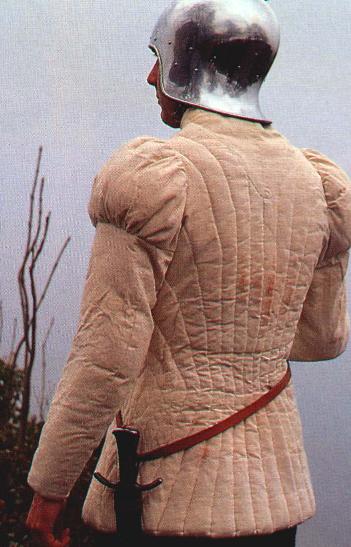
Jack
 Attachment: 40.44 KB Attachment: 40.44 KB
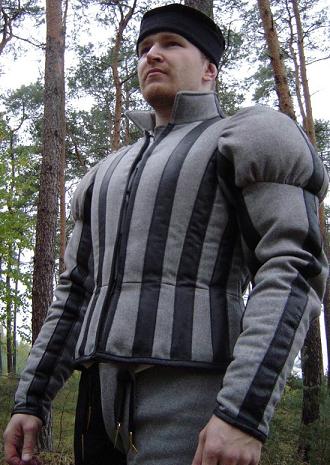
recreation of 15 cent arming doublet
 Attachment: 63.26 KB Attachment: 63.26 KB

iconography of the arming doublet
www.elchon.com
Polish Guild of Knifemakers
The sword is a weapon for killing, the art of the sword is the art of killing. No matter what fancy words you use or what titles you put to
it that is the only truth.
|
|
   |
 |
Folkert van Wijk

|
 Posted: Fri 31 Mar, 2006 5:45 am Post subject: Posted: Fri 31 Mar, 2006 5:45 am Post subject: |
 |
|
I should say: Horse hair, or maybe verry loos wool vilt.....
but I am sertenly no expert...
Folkert
A good sword will only be sharp, in the hands of a wise man…
I am great fan of everything Celtic BC, including there weapons.
|
|
  |
 |
|
George Doby
|
 Posted: Fri 31 Mar, 2006 6:10 am Post subject: Posted: Fri 31 Mar, 2006 6:10 am Post subject: |
 |
|
remember reading somewhere that histoicaly they and arming caps were stuffed w/ horsehair. something bout horse hair gave better padding than anything else. springy more?
don't sweat the petty things, just pet the sweaty things
|
|
  |
 |
|
Wolfgang Armbruster
|
|
  |
 |
Gordon Clark

|
 Posted: Fri 31 Mar, 2006 6:17 am Post subject: Posted: Fri 31 Mar, 2006 6:17 am Post subject: |
 |
|
The two modern pictures above look more like jacks than arming doublets. To me, an arming doublet is a close fitting garmet usually made of multiple layers of linen (5-10 maybe?), but not really a fabric defense. It is used to connect and support armour. A jack is many more layers of linen - up to 30 or so, and is used as a defense itself, sometimes in conjunction with maile.
Some of (both of) these might have been "stuffed", but I believe most were just multiple layers of fabric, quilted together.
Gordon
|
|
  |
 |
Gordon Clark

|
 Posted: Fri 31 Mar, 2006 6:27 am Post subject: Posted: Fri 31 Mar, 2006 6:27 am Post subject: |
 |
|
The guy laying down is in a jack (over maile) made of multiple layers of linen. The other one has an arming doublet of a few layers of linen, with maile sleves sewn on. You can see the points where his armour will be attached at the shoulder. You can also see that the arming doublet holds up his hosen. The jack, on the other hand, does not support, but is in place of armour.
More pics at www.lordgreys.org.
 Attachment: 84.89 KB Attachment: 84.89 KB
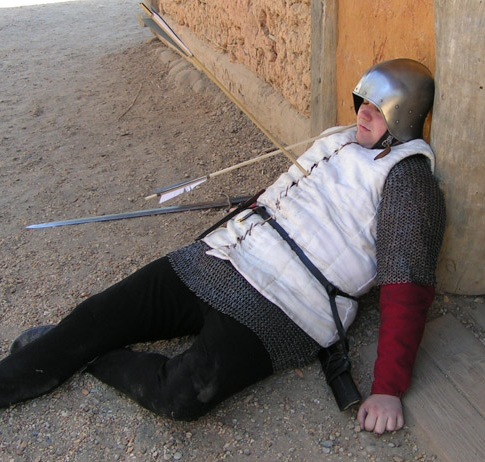
 Attachment: 85.96 KB Attachment: 85.96 KB

|
|
  |
 |
Jessica Finley
Industry Professional

Location: Topeka, Kansas Joined: 29 Dec 2003
Posts: 110
|
 Posted: Fri 31 Mar, 2006 7:59 am Post subject: Posted: Fri 31 Mar, 2006 7:59 am Post subject: |
 |
|
| Gordon Clark wrote: | A jack is many more layers of linen - up to 30 or so, and is used as a defense itself, sometimes in conjunction with maile.
Gordon |
Hey Gordon and all -
Has anyone actually sewn through 30 layers of Linen? How do you do it?
Just asking becuase I have literally blown a sewing machine up on four layers of cotton canvas plus two layers of linen. (pieces flew around my room and everything!) Sewing through an equivalent amount of fabric by hand required me to use a leather-sewing awl, and it ruined the structural integrety of the fabric because of the size and shape of the awl. That's certainly not what you'd want on a garment that could save your life. Even if you're talking incredibly light linen... I can only imagine the struggle it would be to sew it.
Anyone have the magic answer I am missing?
Jess
|
|
     |
 |
Alexi Goranov
myArmoury Alumni


|
 Posted: Fri 31 Mar, 2006 8:14 am Post subject: Posted: Fri 31 Mar, 2006 8:14 am Post subject: |
 |
|
I know of historical account of a "doublet of fence" (arming doublet it appears) of over 20 layers of linen (23 layers I think is the actual number). I do not know how they made it, but that it was done:)
The arming doublets (also called jacks by some) , as Gordon mentions, are usually made of folds of linen quilted together. The stuffed garments are usually, but maybe not always, called gambesons or aketons, and indeed the first picture in the first post looks like a late form of a gambeson or aketon. These were usually stuffed with wool, rags, cotton, or hemp..pretty much anything. Wool and hemp seemed to have been preferred by some as they don't not get soaked in liquids as much as cotton does.
Alexi
|
|
  |
 |
Michal Plezia
Industry Professional

|
 Posted: Fri 31 Mar, 2006 8:25 am Post subject: Posted: Fri 31 Mar, 2006 8:25 am Post subject: |
 |
|
| Quote: | The arming doublets (also called jacks by some) , as Gordon mentions, are usually made of folds of linen quilted together. The stuffed garments are usually, but maybe not always, called gambesons or aketons, and indeed the first picture in the first post looks like a late form of a gambeson or aketon. These were usually stuffed with wool, rags, cotton, or hemp..pretty much anything. Wool and hemp seemed to have been preferred by some as they don't not get soaked in liquids as much as cotton does.
|
The maker of the first one told it was made by 4 layers of linen (on the shoulders several).He calls it (after 'medieval soldier' book -an arming doublet-NOT jack or aketon). So still I don't know what to wear under my plate 
I know that mail was used over mail.But what was used under mail when jack was not used?
www.elchon.com
Polish Guild of Knifemakers
The sword is a weapon for killing, the art of the sword is the art of killing. No matter what fancy words you use or what titles you put to
it that is the only truth.
|
|
   |
 |
Gordon Clark

|
 Posted: Fri 31 Mar, 2006 8:29 am Post subject: Posted: Fri 31 Mar, 2006 8:29 am Post subject: |
 |
|
| Michal Plezia wrote: |
The maker of the first one told it was made by 4 layers of linen (on the shoulders several).He calls it (after 'medieval soldier' book -an arming doublet-NOT jack). So still I don't know what to wear under my plate 
I know that mail was used over mail.But what was used under mail when jack was not used? |
"Arming doublet" implies the ability to attach armour, I think. The first one from your post does not appear to have any attachment points.
Jessica,
This article might be some help:
http://www.bayrose.org/wkneedle/Articles/quilting.html
One quote in particular:
"Quilting through cotton almost always requires a thimble, even if you don’t use one for other stitching, and to stitch through a firmly stuffed area, I find I often need to pull the needle through with pliers."
|
|
  |
 |
Michal Plezia
Industry Professional

|
 Posted: Fri 31 Mar, 2006 9:14 am Post subject: Posted: Fri 31 Mar, 2006 9:14 am Post subject: |
 |
|
| Quote: | The first one from your post does not appear to have any attachment points.
|
There are no attachments points because this man makes clothes usually for people living far away and they never meet.He sends the clothes by mail-without trying on...so not always they fit good.The attachments must be done by customer himself-to fit his armour.But it is not important for our discusssion 
The very similar is on page 34 in "Medieval Soldier"-described as arming doublet.And I think it is a copy(more or less acurate) of the doublet shown on the painting from XV century-in my first post
www.elchon.com
Polish Guild of Knifemakers
The sword is a weapon for killing, the art of the sword is the art of killing. No matter what fancy words you use or what titles you put to
it that is the only truth.
|
|
   |
 |
Jessica Finley
Industry Professional

Location: Topeka, Kansas Joined: 29 Dec 2003
Posts: 110
|
 Posted: Fri 31 Mar, 2006 9:44 am Post subject: Construction Notes Posted: Fri 31 Mar, 2006 9:44 am Post subject: Construction Notes |
 |
|
Alright.
I couldn't stand not knowing, so I ran up to my sewing room and grabbed some linen.
I stitched it down using a running stitch and linen thread (there is NO WAY cotton thread could be strong enough for this application).
One thing, it's very tedious, which is what I expected. The article you mentioned, Gordon, indicates not to use a stabbing motion while stitching (which is a very slow and inexact way to stitch) but with this many layers of cloth, there is no other option that I know of. You may be able to use a leather/canvas stitching awl to get a stronger stitch, but I think you'd run into problems with the size of the awl. I can't see any way to do a backstitch with this many layers.
I will say that the 3.2 oz linen is reasonable to bend (for instance, bending an elbow, or at the waist depending on the tightness of the doublet), however, the 6.0 is so difficult and bulky that I can't imagine that thickness being at any bending area. But, though it's difficult to see in the pictures, the 6.0 gives alot more spring (cushion?), while the 3.2 is much more compact due to the tightness of the weave and the delicacy of the threads.
I can't imagine it being this thick around the shoulders and elbows, simply due to mobility, chafing, etc. I'd imagine it's part of the reason that you see the huge armholes, rather than them actually being at the shoulder joint.
But - I'd like to hear from you guys who've worn more gambesons and armor than myself, do you think that it'd be reasonable to have between 1/2" and 1" of padding underneath your armor? Or is it more reasonable in other applications?
Jess
 Attachment: 89.79 KB Attachment: 89.79 KB
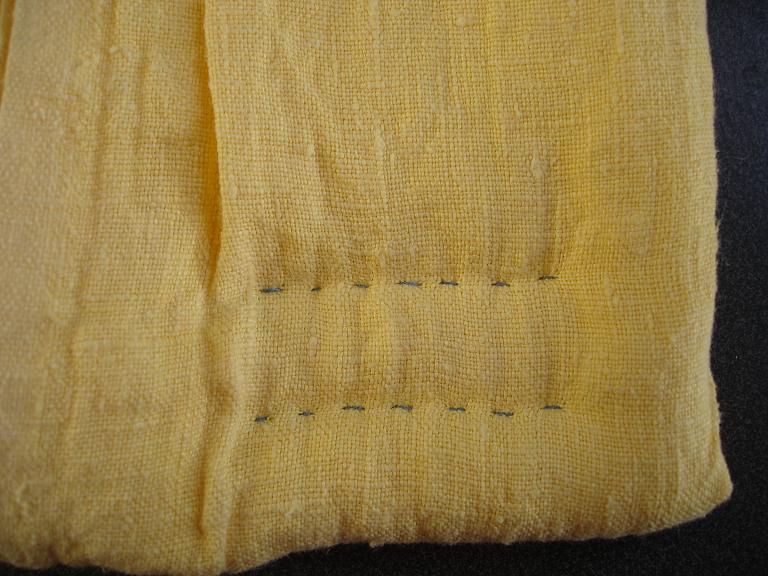
This is 32 layers of 6.0 oz linen stitched down.
 Attachment: 98.13 KB Attachment: 98.13 KB
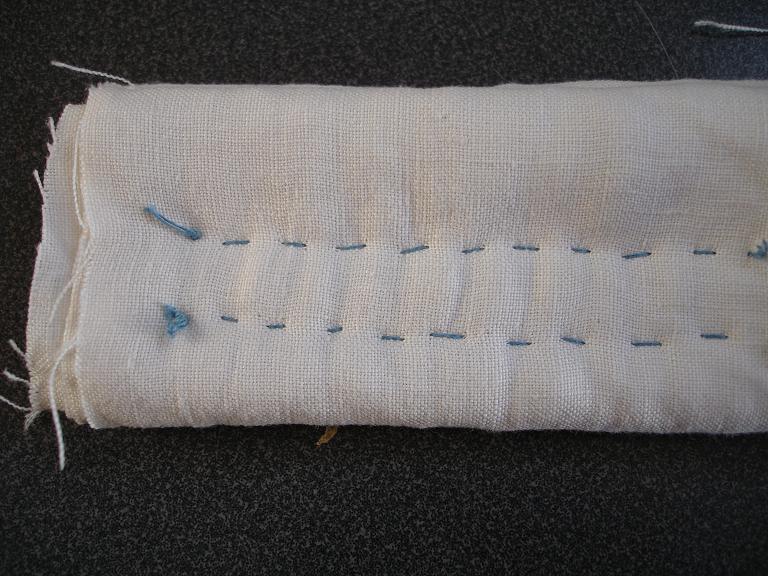
This is 32 layers of 3.2 oz linen stitched down
 Attachment: 71.44 KB Attachment: 71.44 KB
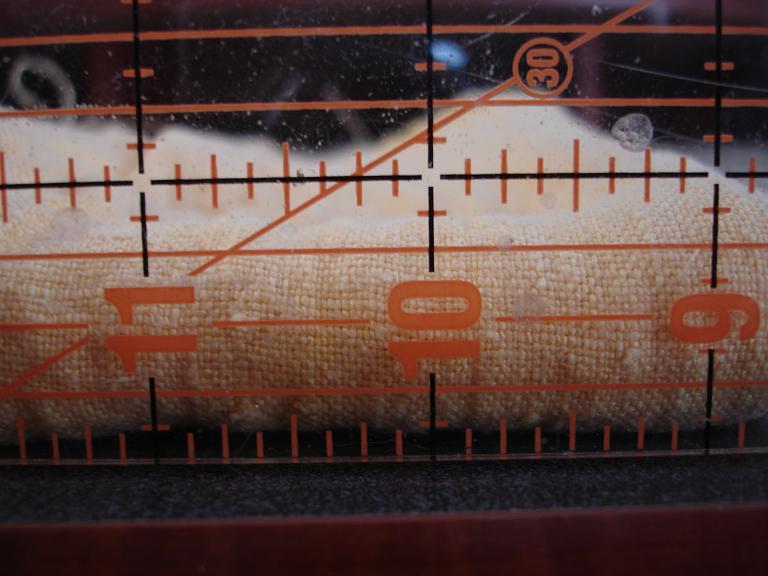
The 6.0 oz linen ended up being between 3/4" and 7/8" thick.
 Attachment: 49.45 KB Attachment: 49.45 KB

The 3.2 oz linen ended up being just at 1/2" thick.
 Attachment: 51.38 KB Attachment: 51.38 KB
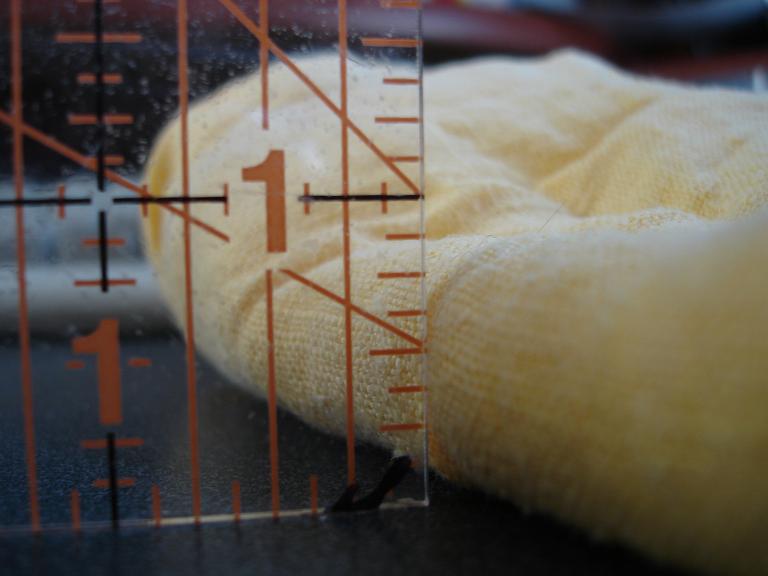
Another Angle
 Attachment: 53.57 KB Attachment: 53.57 KB
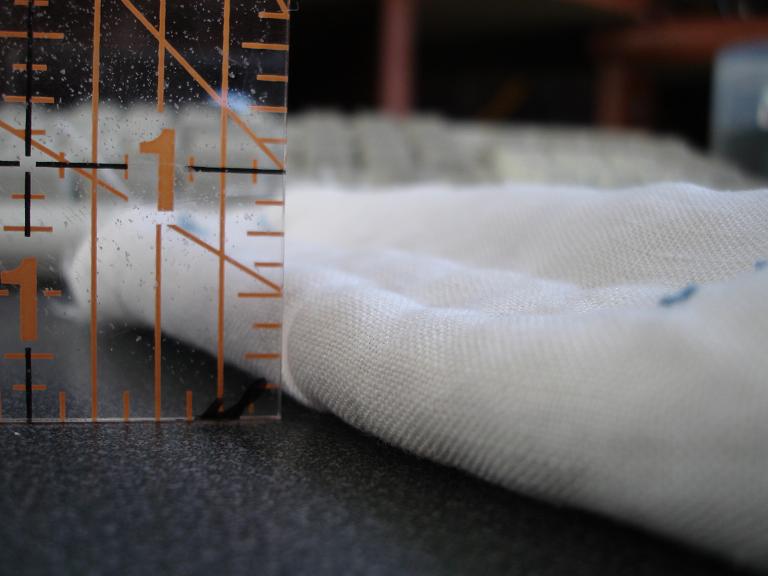
Another angle
|
|
     |
 |
Gordon Clark

|
 Posted: Fri 31 Mar, 2006 9:51 am Post subject: Re: Construction Notes Posted: Fri 31 Mar, 2006 9:51 am Post subject: Re: Construction Notes |
 |
|
| Jessica Finley wrote: | ....
But - I'd like to hear from you guys who've worn more gambesons and armor than myself, do you think that it'd be reasonable to have between 1/2" and 1" of padding underneath your armor? Or is it more reasonable in other applications?
Jess |
Nice pics. Many layers of linen would go into a jack to be worn as a standalone or supplementary defense OVER your armour. That was my point above - an arming doublet is relatively thin and is worn under, a jack is thick and worn alone or over. That said, there are some period illustrations of a breastplate for instance worn over a what looks like a jack or over both a jack and maile...
Gordon
|
|
  |
 |
Michal Plezia
Industry Professional

|
 Posted: Fri 31 Mar, 2006 9:57 am Post subject: Posted: Fri 31 Mar, 2006 9:57 am Post subject: |
 |
|
| Quote: | | That was my point above - an arming doublet is relatively thin and is worn under, a jack is thick and worn alone or over. |
I'm sure You are right.
But it gives no answer to my question- is it made like jack-but fewer layers of linen or it is padded with something else?(rags,wool,horse hair)? I have to buy one and different authors gives different answers!What do You people use under Your plate?
www.elchon.com
Polish Guild of Knifemakers
The sword is a weapon for killing, the art of the sword is the art of killing. No matter what fancy words you use or what titles you put to
it that is the only truth.
|
|
   |
 |
Gordon Clark

|
|
  |
 |
Alexi Goranov
myArmoury Alumni


|
 Posted: Fri 31 Mar, 2006 10:32 am Post subject: Posted: Fri 31 Mar, 2006 10:32 am Post subject: |
 |
|
| Michal Plezia wrote: | | Quote: | | That was my point above - an arming doublet is relatively thin and is worn under, a jack is thick and worn alone or over. |
I'm sure You are right.
But it gives no answer to my question- is it made like jack-but fewer layers of linen or it is padded with something else?(rags,wool,horse hair)? I have to buy one and different authors gives different answers!What do You people use under Your plate? |
If I were you I'd do the former (arming doublet/jack), with fewer layers. Have you considered this product:
http://www.historicenterprises.com/cart.php?m...2&c=44
Alexi
|
|
  |
 |
|
W. R. Reynolds
Location: Ramona, CA Joined: 07 Dec 2004
Posts: 123
|
 Posted: Fri 31 Mar, 2006 7:54 pm Post subject: Posted: Fri 31 Mar, 2006 7:54 pm Post subject: |
 |
|
Michal,
IMHO the arming doublet only has to be thick enough to prevent your armour from chafing you and that is not very thick. As Gordon pointed out the garment in the top photo is clearly a jack and is armour unto itself, is thick enough to withstand incoming blows and can be worn in conjunction with other pieces of armour. The next photo could be an arming doublet of some kind but I do not see any points for the armour to be attached and I am not altogether convinced that huge puffy shoulders are needed to support pauldrons, I think they would have a tendency to push the pauldrons out of position. The most common stuffing for jacks was the many layers of linen but there are a few records of tow, horse hair and wool being used. I have two helmet liners, both linen on the outside, one stuffed with tow and the other with the layered linen. While not as thick as a jack I can see the potential for either stuffing to work as armour, though if the outer layer on the tow stuffed jack were to be sliced open in battle you might lose some of that protection in spite of the quilting.
An arming doublet should not be too thick as it will impair your ability to move which is vital if you are to survive in battle. Mine is an early model custom made by Historic and not one of their generic models that is now being sold on their website (nothing wrong with generic, Jeff is a friend and I happen to live a couple of miles from their shop). It is tight at the hips and waist to support the weight of the leg armour and loose (sort of bloused) above the navel to allow freedom of movement for the arms and shoulders. The area at the throat is closed using a point so that when you attach the pauldrons their weight will not pull the doublet and the armour on top of it out of position. My mail standard is separate from the doublet and covers the opening at the throat or you can wear a bevor or both. Mail voiders could either be pointed on or sewn on.
Hope this helps.
Bill
"No matter who wins the rat race.......they are still a rat."
|
|
  |
 |
|
W. R. Reynolds
Location: Ramona, CA Joined: 07 Dec 2004
Posts: 123
|
 Posted: Fri 31 Mar, 2006 8:20 pm Post subject: Posted: Fri 31 Mar, 2006 8:20 pm Post subject: |
 |
|
Michal,
Tight at the waist to support the legs and loose at the top (no I,m not really that fat, that is the blousing I talked about in my previous post) voiders sewn on. Probably shoud not be wearing the chaperone with this but I need the shade having had several skin cancers cut off my face.
 Attachment: 52.29 KB Attachment: 52.29 KB
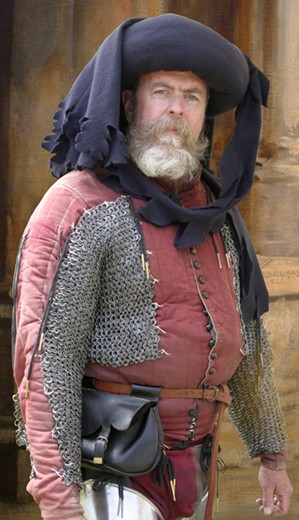
Bill
"No matter who wins the rat race.......they are still a rat."
|
|
  |
 |
Michal Plezia
Industry Professional

|
 Posted: Sat 01 Apr, 2006 3:24 am Post subject: Posted: Sat 01 Apr, 2006 3:24 am Post subject: |
 |
|
| Quote: | Tight at the waist to support the legs and loose at the top (no I,m not really that fat, that is the blousing I talked about in my previous post) voiders sewn on. Probably shoud not be wearing the chaperone with this but I need the shade having had several skin cancers cut off my face.
|
It is just what I have thought.Thanks guys for Your help.Especially for the pictures.If anybody have other pictures of arming dublets they use and are historically acurate -please don't hasitate to post them 
www.elchon.com
Polish Guild of Knifemakers
The sword is a weapon for killing, the art of the sword is the art of killing. No matter what fancy words you use or what titles you put to
it that is the only truth.
|
|
   |
 |
James Barker

Location: Ashburn VA Joined: 20 Apr 2005
Posts: 365
|
 Posted: Mon 03 Apr, 2006 6:49 am Post subject: Posted: Mon 03 Apr, 2006 6:49 am Post subject: |
 |
|
| Michal Plezia wrote: | | Quote: | | That was my point above - an arming doublet is relatively thin and is worn under, a jack is thick and worn alone or over. |
I'm sure You are right.
But it gives no answer to my question- is it made like jack-but fewer layers of linen or it is padded with something else?(rags,wool,horse hair)? I have to buy one and different authors gives different answers!What do You people use under Your plate? |
Michal
No one can be for sure all we can do is speculating based on earlier and later extent pieces and writing of the times. In How a Man Shall be Arymed it says:
| Quote: | | He shall have no shirt upon him except for a doublet of fustian lined with satin, cut full of holes. The doublet must be strongly built; the points must be set at the break in the arm in the front and back. To lace the gussets of mail must be sewn onto the doublet also at the break in the arm and at the underarm. |
So we know that the outer layer should be Fustian (a material that is linen the long way and cotton the short way) and have a silk satin inner layer, likely because no shirt is worn under it.
Now on stuffing. There are several surviving armors and a 16th century arming doublet.
The Black Prince garment is an armor worn over maille, according to Janet Arnold it is 3 layers of material 2 linen and one layer of silk/linen velvet on the outside (the pile or fuzzy part was silk the backing was linen) and between the 2 layers of linen was cotton wool (Euro term for raw cotton).
Then there is the Charles the VI cote armor (jupon) from around 1400. It was worn over maille or a brigandine and it is 7 layers of cloth and 2 layers of cotton wool. From the inside out it is 2 linen, cotton wool, 2 linen, cotton wool, 2 linen, and the silk damask on the outside.
From the 15th century there are 3 jacks in museums in Europe. 2 in the Holstentor Museum in Lübeck Sweden, only one is on display and there is one in a museum in Stendal which is Sweden or Germany I am not sure. These examples are 2 layers of linen canvas with cotton wool stuffing. At least one was worn with a breast plate over the front, there is rust on from and there are only 3 sets of points to close it, which is not enough to be safely worn without a breastplate over it.
Janet Arnold has a 16th century piece in her book "Patterns of Fashion: The Cut and Construction of Clothes for Men and Women C1560-1620". It is 4 layers of material with cotton wool stuffing; this is how many 15th century guys also make their arming doublets.
While I am at it here are some historical texts on Jacks:
| Quote: | From the ordinance of St. Maximin de Treves, published October of 1473.
In the section describing the equipment of members of a lance - specifically the mounted archer "The mounted archer must possess a horse worth not less than six francs, and should wear a visorless sallet, a gorget (This may mean a maille standard or bevor), a brigandine, or a sleeveless mail shirt under a ten layer jack" |
| Quote: | From the Ordinances of Louis XI of France (1461-1483)
And first they must have for the said Jacks, 30, or at least 25 folds of cloth and a stag's skin; those of 30, with the stag's skin, being the best cloth that has been worn and rendered flexible, is best for this purpose, and these Jacks should be made in four quarters. The sleeves should be as strong as the body, with the exception of the leather, and the arm-hole of the sleeve must be large, which arm-hole should be placed near the collar, not on the bone of the shoulder, that it may be broad under the armpit and full under the arm, sufficiently ample and large on the sides below. The collar should be like the rest of the Jack, but not too high behind, to allow room for the sallet. This Jack should be laced in front, and under the opening must be a hanging piece [porte piece] of the same strength as the Jack itself. Thus the Jack will be secure and easy, provided that there be a doublet [pourpoint] without sleeves or collar, of two folds of cloth, that shall be only four fingers broad on the shoulder; to which doublet shall be attached the chausses. Thus shall the wearer float, as it were, within his jack and be at his ease; for never have been seen half a dozen men killed by stabs or arrow wounds in such Jacks, particularly if they be troops accustomed to fighting." |
BTW I am the dead guy with the maille and jack in Gordon's photo, my jack is 15 layers of linen. I hand quilted it because a machine just can't do that plus it is not correct for a living history garment to have machined stitching. A needle used by hand can pass through 15 layers without and issue.
|
|
   |
 |
|
|
You cannot post new topics in this forum
You cannot reply to topics in this forum
You cannot edit your posts in this forum
You cannot delete your posts in this forum
You cannot vote in polls in this forum
You cannot attach files in this forum
You can download files in this forum
|
All contents © Copyright 2003-2024 myArmoury.com — All rights reserved
Discussion forums powered by phpBB © The phpBB Group
Switch to the Basic Low-bandwidth Version of the forum
|

